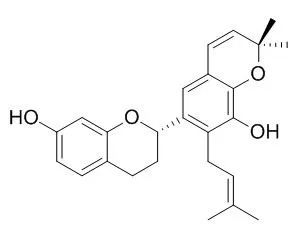Kazinol B, a natural isoprenylated flavan, stimulated the [Ca(2+)](i) elevation in the presence or absence of Ca(2+) in the medium.
METHODS AND RESULTS:
Treatment with chymotrypsin or phorbol 12-myristate 13-acetate to shedding of L: -selectin had no effect on subsequent Kazinol B-induced Ca(2+) response. Upon initial cyclopiazonic acid (CPA) treatment in the absence of external Ca(2+), the subsequent [Ca(2+)](i) rise followed by challenge with Kazinol B was greatly diminished. The ryanodine receptor blockers, 8-bromo-cyclic ADP-ribose and ruthenium red did not affect Kazinol B-evoked Ca(2+) release from internal stores. However, the inhibitors of sphingosine kinase, dimethylsphingosine, but not dihydrosphingosine, inhibited Kazinol B-induced Ca(2+) release. Kazinol B-induced [Ca(2+)](i) rise was not affected by two nitric oxidase inhibitors, N-(3-aminomethyl)benzylacetamidine (1400W) and 7-nitroindazole, cytochalasin B and Na(+)-deprivation.Kazinol B did not evoke any appreciable Ba(2+) and Sr(2+) entry into cells. The Ca(2+) entry blockers, 1-[beta-[3-(4-methoxyphenyl)propoxy]-4-methoxyphenethyl]-1H-imidazole (SKF-96365), but not cis-N-(2-phenylcyclopentyl)azacyclotridec-1-en-2-amine (MDL-12,330A), inhibited a Kazinol B-induced [Ca(2+)](i) rise. Kazinol B had no effect on the pharmacologically isolated plasma membrane Ca(2+)-ATPase activity. In a Ca(2+)-free medium, Kazinol B inhibited the subsequent Ca(2+) addition, resulting in robust entry in CPA- and formyl peptide-activated cells. Kazinol B produced a concentration-dependent reduction in the mitochondrial membrane potential.
CONCLUSIONS:
These results indicate that Kazinol B stimulates Ca(2+) release from internal Ca(2+) store, probably through the sphingosine 1-phosphate and IP(3) signaling, and activates external Ca(2+) influx mainly through a non-store-operated Ca(2+) entry (non-SOCE) pathway. Inhibition of SOCE by Kazinol B is probably attributable to a break in the Ca(2+) driven force of mitochondria. |






 Cell. 2018 Jan 11;172(1-2):249-261.e12. doi: 10.1016/j.cell.2017.12.019.IF=36.216(2019)
Cell. 2018 Jan 11;172(1-2):249-261.e12. doi: 10.1016/j.cell.2017.12.019.IF=36.216(2019) Cell Metab. 2020 Mar 3;31(3):534-548.e5. doi: 10.1016/j.cmet.2020.01.002.IF=22.415(2019)
Cell Metab. 2020 Mar 3;31(3):534-548.e5. doi: 10.1016/j.cmet.2020.01.002.IF=22.415(2019) Mol Cell. 2017 Nov 16;68(4):673-685.e6. doi: 10.1016/j.molcel.2017.10.022.IF=14.548(2019)
Mol Cell. 2017 Nov 16;68(4):673-685.e6. doi: 10.1016/j.molcel.2017.10.022.IF=14.548(2019)